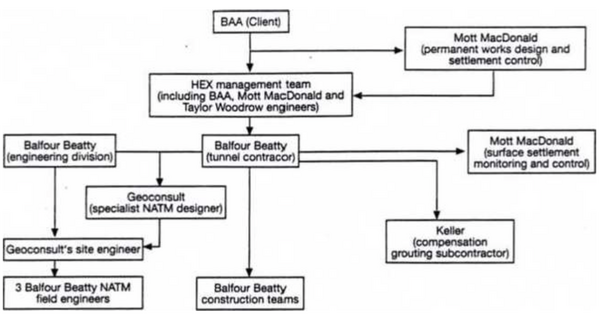The light at the end of the tunnel: managing challenges at Heathrow Express Project
| Line 11: | Line 11: | ||
== Context== | == Context== | ||
| − | [ [ | + | |
| + | [[File:Organizational_chart_Heathrow_Express.png|600px|thumb|right|Organizational chart appointed for the project administration]] | ||
| + | |||
| + | |||
| + | |||
==Challenge== | ==Challenge== | ||
Revision as of 14:02, 13 September 2016
- WIP***
The Heathrow Express Tunnel Project was intended as a way to connect Heathrow airport with Paddington station in central London. The project, managed and bided by the British Airport Authority (BAA), was to be constructed by Balfour Beatty (BB), a major and well-known construction firm. As part of the design, BB wanted to introduce the use of a construction technique named New Austrian Tunneling Method (NATM) for the first time in the UK. Consequently, they recruited the services of the technique’s Austrian expert firm Geoconsult. The project was planned to start in 1994.
The project management faced a multitude of difficulties from the start. Among them were a restrictive economic environment, a rigid and complex organization and technical problems with the implementation of a poorly understood technology (NATM). Several decisions taken directly as a result of this scenario jeopardized the entire project and led to the tunnel collapse occurred in the night of October 21st, 1994.
The jointly project management confronted the emergency introducing organizational changes to overcome the disastrous situation; under a new structure, the team gradually repaired the tunnel and finished the project. The namely “Solution team” developed a 12-month plan which included a conservative-approach solution with the construction of a cofferdam (at the time, the greatest ever constructed in Britain). They also recommended continue using NATAM technique for the tunnel construction, after an investigation carried out by the Health and Safety Executuve (HSE) certified the safety of the method.[1]
Ultimately, the plan succeeded, and the delay was reduced from 12 to only 6 months, and the project-works were concluded in 1998. Subsequently, an HSE investigation on both BB and Geoconsult led to their indictment and prosecution. They were charged with £1,3 million and £600.000 respectively. The case refaced the way to approach construction projects in Britain, including additional requirements and standards for NATM’s tunnel-projects.[2]
Contents |
Context
Challenge
Challenge
Challenge
Solution
Implication
Implication
References
- ↑ Health and Safety Executive. Safety of the New Austrian Tunneling Method (NATM) Tunnels. London, UK, 1996. Retrieved 14Mar2016 from HSE Available online version
- ↑ Wallis, S. (1999). Heathrow failures highlight NATM (abuse?) misunderstandings. Tunnel, 3/99, 66–72. Retrieved on 30Mar2016 from Available online version
